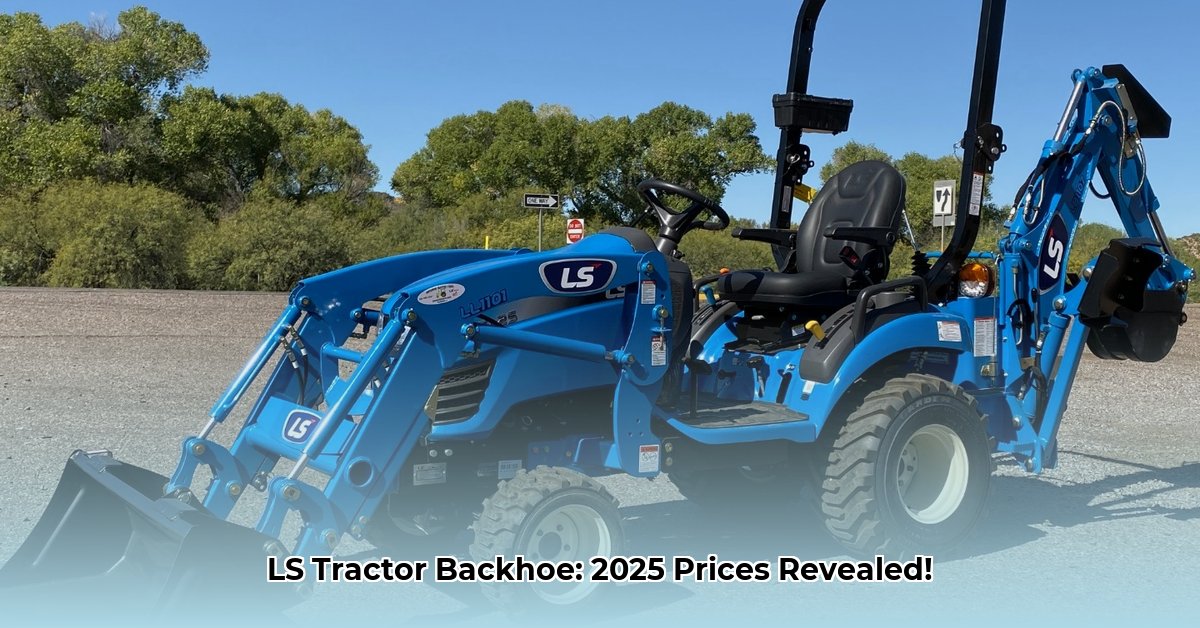
Understanding the LS Tractor with Backhoe Market
Finding the right LS tractor with a backhoe can be challenging due to price variability and inconsistent information. This guide helps you navigate the market and make an informed decision. For more detailed information on tractor backhoes, check out this helpful resource: Tractor Backhoe Guide.
Market Overview: Navigating Price Fluctuations and Feature Variations
The market for LS tractors with backhoes is active, but data inconsistencies are common. Prices vary widely, even for seemingly identical models, due to dealer markups, fluctuating demand, and the tractor's age and condition. Differences of thousands of dollars between similar tractors are entirely possible. This highlights the importance of thorough research and due diligence. Don't be afraid to ask pointed questions about pricing and features.
Key Features to Consider: Power, Traction, and Control
Before browsing, prioritize key features:
- Horsepower: Determines the tractor's workload capacity. Higher horsepower means increased power but also higher cost. Match the horsepower to your needs. A smaller tractor works fine for smaller jobs but won't handle large loads as well as more powerful models.
- 4WD/MFWD: Crucial for uneven terrain. Four-wheel drive (4WD) provides superior traction, especially in hilly or muddy conditions. Mechanical front-wheel drive (MFWD) often offers more cost-effective traction than full 4WD.
- Transmission: Impacts ease of use and efficiency. Hydrostatic transmissions generally provide smoother operation and better fuel efficiency than synchromesh transmissions; which offer more flexibility.
- PTO (Power Take-Off): Essential for powering attachments like the backhoe. Check the PTO horsepower rating to ensure it's sufficient for your backhoe's operation. Variations in PTO speed and configurations are significant and are often different in models for the US versus those marketed internationally.
- Hydraulics: This determines how smoothly the backhoe functions and how much it can lift. Higher hydraulic flow rates and pressures indicate greater lifting capacity and smoother performance.
| Feature | Importance | Considerations |
|---|---|---|
| Horsepower | Determines the workload capacity. | Match to your specific needs and budget. |
| 4WD/MFWD | Essential for traction on uneven terrain. | Consider your typical working conditions. |
| Transmission | Affects ease of use and efficiency. | Hydrostatic is often smoother and more fuel efficient. |
| PTO | Powers implements and attachments. | Check horsepower and available speeds to meet backhoe needs. |
| Hydraulics | Influences backhoe lifting capacity and smoothness. | Higher flow rates and pressures translate to better performance. |
Price Analysis: Understanding the Variables
The price of used LS tractors with backhoes varies greatly. Factors influencing cost include model, age, condition, additional features, and—crucially—dealer markup. A 2020 model will generally be cheaper than a newer one, but remember to account for potential future repair costs. The lack of consistent pricing data emphasizes the need for multiple quotes and thorough price justification from each seller. Always ask detailed questions before committing to a purchase.
Your Step-by-Step Buying Guide: A Proven Process
- Research Models and Specifications: Compare models side-by-side, focusing on specific features that matter most to you. Don't solely focus on the lowest price.
- Locate Reputable Dealers: Check online reviews and seek recommendations from other LS tractor owners. A trustworthy dealer enhances the overall buying experience.
- Conduct a Pre-Purchase Inspection: A thorough inspection, ideally by an independent mechanic skilled in agricultural equipment, is vital. Look for signs of wear and tear, mechanical problems, and any other potential issues.
- Negotiate a Fair Price: Confidently negotiate using the information gathered during research. Don't hesitate to walk away if the deal isn't satisfactory.
Mitigating Risks: Strategies for Informed Purchasing
Price volatility, inconsistent information, and the inherent risks of buying used equipment necessitate proactive risk mitigation:
- Obtain Multiple Quotes: Compare quotes and specifications from several dealers to identify the best value.
- Hire an Independent Inspector: An independent inspection can prevent costly surprises later on.
- Use Detailed Contracts: Ensure the sales contract clearly defines the tractor's condition, terms of sale, and warranties.
Addressing Data Inconsistencies: Where to Find Reliable Information
The lack of consistent information is a common challenge. Supplement dealer information with other resources, such as online forums dedicated to agricultural machinery, contacting LS Tractor directly, or consulting independent agricultural publications. Don't rely on a single source.
How to Compare LS Tractor PTO Specifications Across Different Models
Key Takeaways:
- Significant differences exist between US and international LS tractor models, affecting PTO specifications and other key features.
- User feedback is invaluable in understanding practical performance and limitations.
- Careful comparison of specifications is essential before purchasing to ensure compatibility with your needs and equipment.
The PTO system is critical for operating implements. Models vary considerably in PTO horsepower, available speeds, engagement type (independent or dependent), and shaft design. Discrepancies can occur between official specifications and real-world performance, hence the need to consult user reviews.
Comparing PTO Specifications: A Step-by-Step Guide
- Define Your Needs: What implements will you use, and what are their power requirements?
- Gather Data: Obtain detailed specifications for all models of interest from official sources and user reviews.
- Compare PTO Features: Create a comparison table highlighting PTO horsepower, speeds (RPM), engagement type, and shaft diameter and style.
- Check for Inconsistencies: Note any discrepancies between various sources; this is common.
- Consult Experts: Seek advice from experienced mechanics or agricultural experts if needed.
- Consider the Total Package: Evaluate warranty, service accessibility, and dealer reputation comprehensively.
Conclusion: Making a Smart Tractor Investment
Purchasing a tractor is a substantial investment. Thorough research is critical to avoid problems and get a machine that fits your needs. This guide offers a foundation for your decision, but continuous vigilance and further research remain crucial. Remember that the market and model specifications can change, so stay informed!